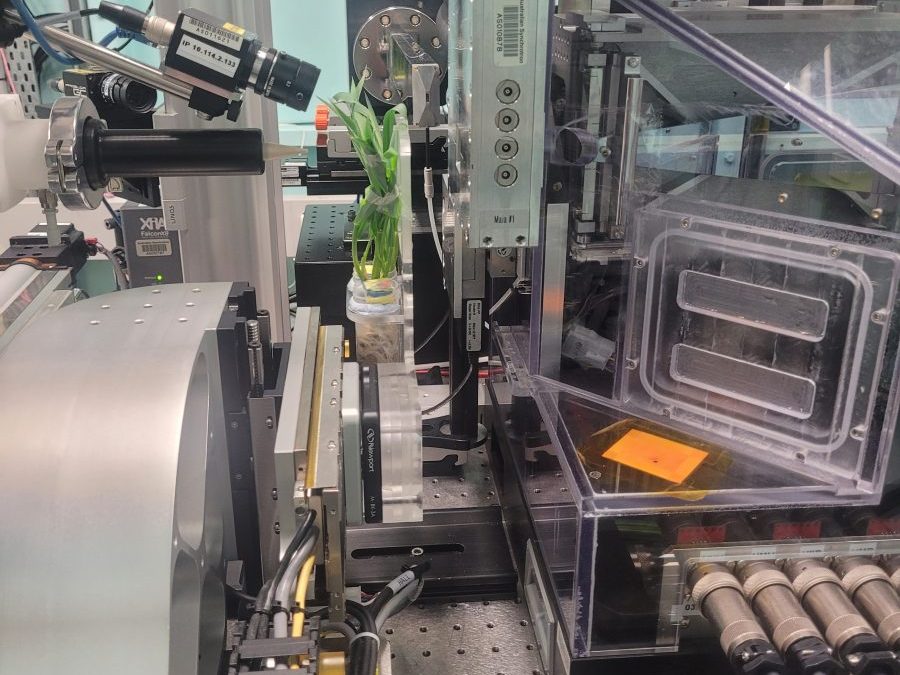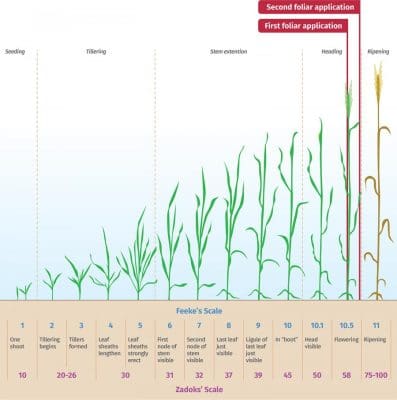
In vivo analysis of novel zinc foliar formulations on wheat plants at the XFM beamline. Photo: Tona Sanchez-Palacios
A MURDOCH University researcher is leading a study using unique nuclear capabilities to gain ground-breaking information about how wheat crops take in administered micronutrients to help farmers produce better crops.
Research Fellow at Murdoch University’s Centre for Sustainable Farming Systems, Dr Tona Sanchez-Palacios, said the goal of the study was to find the best time and method to apply zinc to Australian wheat crops.
“Soil conditions are challenging for farmers in Australia, and they really need to put a lot of fertilisers in crops to achieve high yield potential,” Dr Sanchez-Palacios said.
“Our research involved producing and testing fertilisers that lead to the biofortification of wheat grain with zinc to learn the best time to apply zinc to Australian wheat crops.”
“Applying foliar fertilisers to boost the nutritional value of grains is a method that local farmers can adopt to maintain grain quality and provide the required nutrition needed for human health, especially in a population recovering from COVID.”
As well as using element mapping techniques at the Australian Nuclear Science and Technology Organisation (ANSTO), Dr Sanchez-Palacios also needed nuclear techniques.
“Nuclear techniques give us a very sensitive way of determining the mechanisms at work in our novel foliar formulations tested on wheat plants,” said Dr Sanchez-Palacios.
“Having access to a radioactive form of zinc and being able to apply it to the plants in a safe environment is very important.”
Using zinc radioisotopes produced at ANSTO’s OPAL research reactor, Dr Sanchez-Palacios worked alongside ANSTO representatives to apply them to the plant and then traced their biodistribution using a radiographic technique.
The technique revealed the amount of zinc absorbed and precisely where the zinc moved from the site of application or has been transported in the plant body, including the grain.
While the application of zinc as a micronutrient improves the quality of the grains, it can be costly to farmers to apply to wheat.
Therefore, knowing when and how much zinc to apply is critical for this technique to be adopted in agricultural systems.

Growth cycle of wheat. red lines indicate when zinc was applied. Photo: ANSTO
ANSTO’s Dr Tom Cresswell said the challenge around agriculture in Australia, and the purpose of agricultural research generally, is finding ways to make the most out of the available land and the available resources that we have.
“Anything that we can do to maximise the quality, minimise the costs and improve the yield for farmers and the quality of the crops for consumers is crucial.”
Dr Cresswell explained that when the plant is imaged using autoradioagraphy, the area where the zinc appears as a bright spot.
“It allows us to assess the uptake of micronutrients when administered in different applications.
“We want the nutrient to reach the edible part of the plants, where it is most beneficial to the person or animal consuming the grain,” he said.
Preliminary indications suggest the scientists are gaining the information they want.
Project work will continue using the X-ray fluorescence microscopy beamline at the Australian Synchrotron – a technique that reveals the spatial distribution of the foliar applied zinc on a single leaf in vivo producing highly detailed images of agronomically biofortified grains produced in Western Australia wheat fields.
Source: Murdoch University, ANSTO

HAVE YOUR SAY